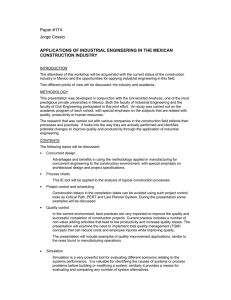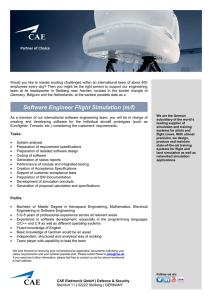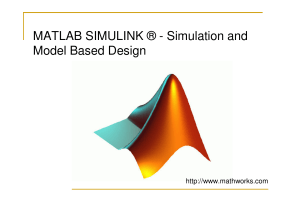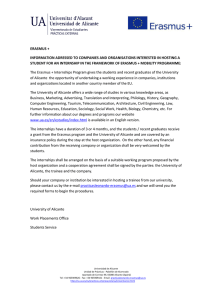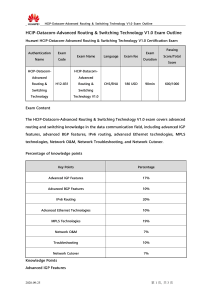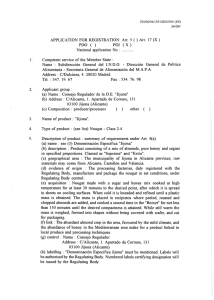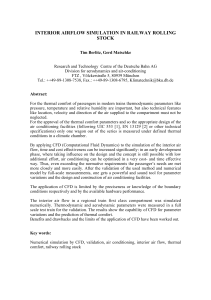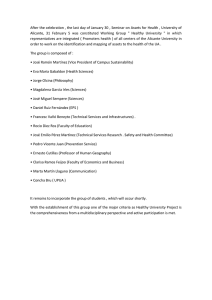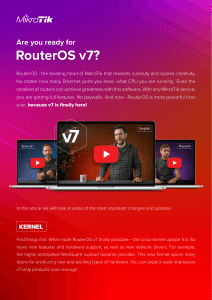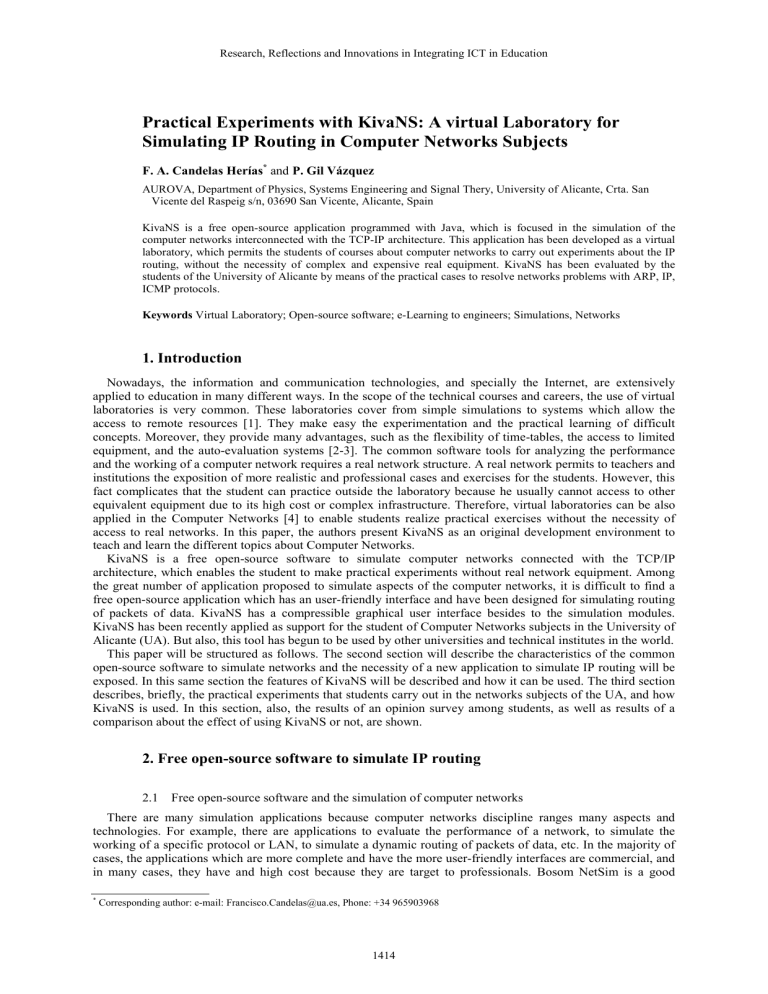
Research, Reflections and Innovations in Integrating ICT in Education Practical Experiments with KivaNS: A virtual Laboratory for Simulating IP Routing in Computer Networks Subjects F. A. Candelas Herías* and P. Gil Vázquez AUROVA, Department of Physics, Systems Engineering and Signal Thery, University of Alicante, Crta. San Vicente del Raspeig s/n, 03690 San Vicente, Alicante, Spain KivaNS is a free open-source application programmed with Java, which is focused in the simulation of the computer networks interconnected with the TCP-IP architecture. This application has been developed as a virtual laboratory, which permits the students of courses about computer networks to carry out experiments about the IP routing, without the necessity of complex and expensive real equipment. KivaNS has been evaluated by the students of the University of Alicante by means of the practical cases to resolve networks problems with ARP, IP, ICMP protocols. Keywords Virtual Laboratory; Open-source software; e-Learning to engineers; Simulations, Networks 1. Introduction Nowadays, the information and communication technologies, and specially the Internet, are extensively applied to education in many different ways. In the scope of the technical courses and careers, the use of virtual laboratories is very common. These laboratories cover from simple simulations to systems which allow the access to remote resources [1]. They make easy the experimentation and the practical learning of difficult concepts. Moreover, they provide many advantages, such as the flexibility of time-tables, the access to limited equipment, and the auto-evaluation systems [2-3]. The common software tools for analyzing the performance and the working of a computer network requires a real network structure. A real network permits to teachers and institutions the exposition of more realistic and professional cases and exercises for the students. However, this fact complicates that the student can practice outside the laboratory because he usually cannot access to other equivalent equipment due to its high cost or complex infrastructure. Therefore, virtual laboratories can be also applied in the Computer Networks [4] to enable students realize practical exercises without the necessity of access to real networks. In this paper, the authors present KivaNS as an original development environment to teach and learn the different topics about Computer Networks. KivaNS is a free open-source software to simulate computer networks connected with the TCP/IP architecture, which enables the student to make practical experiments without real network equipment. Among the great number of application proposed to simulate aspects of the computer networks, it is difficult to find a free open-source application which has an user-friendly interface and have been designed for simulating routing of packets of data. KivaNS has a compressible graphical user interface besides to the simulation modules. KivaNS has been recently applied as support for the student of Computer Networks subjects in the University of Alicante (UA). But also, this tool has begun to be used by other universities and technical institutes in the world. This paper will be structured as follows. The second section will describe the characteristics of the common open-source software to simulate networks and the necessity of a new application to simulate IP routing will be exposed. In this same section the features of KivaNS will be described and how it can be used. The third section describes, briefly, the practical experiments that students carry out in the networks subjects of the UA, and how KivaNS is used. In this section, also, the results of an opinion survey among students, as well as results of a comparison about the effect of using KivaNS or not, are shown. 2. Free open-source software to simulate IP routing 2.1 Free open-source software and the simulation of computer networks There are many simulation applications because computer networks discipline ranges many aspects and technologies. For example, there are applications to evaluate the performance of a network, to simulate the working of a specific protocol or LAN, to simulate a dynamic routing of packets of data, etc. In the majority of cases, the applications which are more complete and have the more user-friendly interfaces are commercial, and in many cases, they have and high cost because they are target to professionals. Bosom NetSim is a good * Corresponding author: e-mail: Francisco.Candelas@ua.es, Phone: +34 965903968 1414 Research, Reflections and Innovations in Integrating ICT in Education example of a complete commercial solution, which is focused on CCNA and CCNP certifications of Cisco Systems. In contrast, the open source software has important advantages, such as the possibility of increasing extensively the features of the application and the option of other teachers or institutions to include new modules and adequate it to the contents of their subjects. Nowadays, there are also many free applications, but the more complete have user interfaces based in programming languages which are not quite intuitive. This is the case of “J-Sim Network Simulator” [5], which is a general network simulator programmed in Java and J-Sim (JavaSim) [5-6], but it requires programming to prepare the simulation and get the results, and it has not a homogeneous graphical user interface. Other powerful and popular free open-source software is “ns” (network simulator) [7], which is able to simulate TCP, routing, and multicast protocols. However, “ns” requires that the user specifies the network structure by programming in Tcl/TK language, and the user interface is basically an animation tool used mainly to display the results. The “cnet network simulator” is other interesting free option [8-9]. It simulates different layers and technologies of the network architecture. However, “cnet” is mainly focused in evaluating the performance of data transmissions, and it has the disadvantage of being specifically programmed in C language for some Linux or Unix systems. The “TCP Flow Control Simulation and Visualization” [10] is a good example of simulation software for a specific protocol because it is centred in the evaluation of the performance of the Transmission Control Protocol of the TCP/IP architecture. In relation to the simulation of the IP routing scheme, which is an important aspect in the courses presented in the Section 3, it is difficult to find free applications, and more difficult to find open-source software. A very interesting example of this kind of applications is the “IP Routing Simulation” [11], programmed as a Java applet. Although this application is suitable to introduce how IP routing works and the data fragmentation to students, it is very simple. Moreover, it does not consider different link layer technologies neither advanced routing aspects. 2.2 Necessity of a new application for simulating IP routing Keeping in mind the aspects commented in the previous sections, the necessity of a new application which considers all the following characteristics is arisen: −Free software. The application can be used by our students or other people without any cost. −Open-source software. The source code has to be available to be modified as well as flexible to improve it with new modules. This fact permits that the application be updated with new network technologies and protocols. −Portable software. The application has to be able to run in different platforms or operating systems. To reach this objective, Java is a good option [3]. −User-friendly graphical interface. The student of a Computers Networks subject should be centred in the operation of the networks, and he should not spend time in programming. −The application should be targeted to the IP routing simulation, considering several technologies for the link layer. As it was explained in the section 2.1, is very difficult to find applications for simulating IP routing which suit the above-mentioned characteristics and be enough complete at the same time. In this way, the author’s research group have designed and implemented a application called KivaNS (Kiva Network Simulator), which will be described better in the following sections. As curiosity, a kiva is a room used by some ancient American Natives for spiritual ceremonies. The application is available in http://www.aurova.ua.es/kiva/index.html. 2.3 Architecture of KivaNS KivaNS is composed of three main blocks programmed completely in Java, as Figure 1.a shows. The first block includes all the classes that implement the available equipment and networks, as well as the simulation engine. The second one is an API (Application Programming Interface), which facilitates the use of the simulation modules from different Java applications. The third module is a comprehensive graphical environment to use the simulation modules without the need of programming. Since all the blocks are programmed in Java, they can run in different platforms and operating systems. In addition, the simulation API is independent from the graphical user-interface and it can be used from other Java applications to program specific simulation software. The simulation engine is based on a simple discrete event manager. This event manager attends and schedules events from two different sources (Figure 1.b): the modules that implement the networks and the modules that implement the available equipment. The equipment modules also access to other modules which manages the communications in the different layers of the network architecture. 1415 Research, Reflections and Innovations in Integrating ICT in Education a) Fig. 1 b) a) Architecture of KivaNS. b) Simulation modules of KivaNS. 2.4 Main features of KivaNS The main features that KivaNS offers in comparison to other free open-source applications are the following: −Complete graphical user-interface to draw network schemes and configure the parameters of the equipment and networks. The graphical environment also can be used as a good editor to draw network schemes. This interface will be described in next section. −Support for different layers for the network architecture. Nowadays, the current version has several link layer technologies in addition to IP and other auxiliary protocols. −The parts of the application have a modular architecture which facilitate to include new networks, additional equipment, and even new layers for the network architecture. −Configuration of interfaces and IP routing tables in the equipment, in a way very similar to the routing tables of real operating systems. It is possible to configure the MTU (Maximum Transmission Unit) of the link layer and evaluate the fragmentation of the packets of data. −The simulation manages the addresses of the link layer in addition to the IP addresses. To do this, the ARP protocol (Address Resolution Protocol) has been also implemented. −The IP protocol is helped by the protocol ICMP (Internet Control Message Protocol) to resolve common networks problems, like in the real networks. The more frequent ICMP error messages have been implemented. It is also possible to disable specific errors. Transmission of packets of data inside ICMP messages of “echo”, like the popular program “ping”. It is possible to schedule several transmissions to be simulated. Moreover, networks can be configured to generate specific or random errors. −The simulation can be carried out either step by step or full. During the simulation, a trace of the frames and packets which are involved in the scheduled transmissions is displayed. Figure 2.a shows the layers and modules of the TCP-IP network architecture which have been considered and implemented up to now. Two kinds of the Ethernet link layer have been considered: a simplified version of the original IEEE 802.3 with CSMA/CD access over a bus or a hub topology, and the IEEE 802.3 implemented with switches. Furthermore, Figure 2.b shows how is possible to edit the route table of a router to add, change or delete entries and this way simulate the IP protocol and the routing of a network. With relation to the equipment, the current version of the applications can simulate three kinds of elements in addition to the wires and the network buses. These are the following: computers, routers and switches. In addition, when a user finishes the drawing of a network scheme, he can validate it to find important errors in the interfaces, routing tables or connections. Afterwards, he can schedule different data transmission between pairs of computers by specifying some parameters such as the IP source and destination addresses, the size of the data and the option of fragmenting data. Next, the user can start the simulation, and perform it step by step or fully. 3. Teaching computer networks at the University of Alicante 3.1 Practical experiments The practical experiments of the “Networks” subjects have the main aim of presenting real cases to the student, according to the professional demand and the career that they study. For that reason, practical experiments are mainly about the interconnection of computer networks by using TCP-IP architecture. Thus IP routing it is considered very important in the practices. In the practical cases, the students have to use free software tools to analyze several aspects such as: the type of packets which are built by different software applications and protocols, how are routed these packets through several types of network (Ethernet, PPP, Token-Ring, WiFi, etc.), the possible errors and problems in the network, and how resolve these problems. For this, an interconnection of several networks with professional 1416 Research, Reflections and Innovations in Integrating ICT in Education equipment it is available in the laboratory at our University. Equipment is composed by several routers and servers, in addition to the students’ PCs. a) b) Fig. 2 a) Layers and protocols currently considered in KivaNS. b) Examples of window with the properties of a router and with the trace of a simulation. The main free software that has been employed up to now is a network protocol analyzer or sniffer called Wireshark [12]. This software has all of the standard features which are expected in a protocol analyzer. Wireshark only can analyze the traffic of packets previously captured in a network implemented physically. Thus, students need a network to run Wireshark, and they usually cannot access to other suitable network apart from the laboratory at the University. This is the main reason because KivaNS has been designed. KivaNS has been designed to build virtual networks and to verify what packets are generated in different situations and how they are routed. In this way, the students can analyze the routing without the necessity of a real network. In this work, our students are evaluated for practical exercises in the same laboratory where the network is available. In the evaluation, they have to resolve a list of questions about cases which are similar to the proposed during the laboratory sessions using Wireshark. KivaNS can aid to students to prepare this evaluation in home or in another place apart from the laboratory. In particular, three kinds of exercises or questions have been made to evaluate them: Exercises about ARP, IP and ICMP protocols. In particular, the routing configuration and IP protocol are evaluated from the drawn scheme of the network (Figure 3.a) and from configuration of the properties of interconnecting devices employed (Figure 2.b). This way, the practical experiment simulates the IP protocol behaviour of real network. 3.2 Student Opinion about KivaNS and Evaluation of student’s learning using KivaNS Some statistic studies about the use of KivaNS have been carried out. The evaluation of the student opinion has been produced from data statistics obtained from different interviews which have been made by 35 students of “Networks Courses” during the last year. Only 35 students have decided to give their opinions about KivaNS although 43 did experimentation with it. In the interviews, the students have given their opinion like users answering 15 questions. The questions have covered several topics and aspects. The 52% of students have not had any kind of problems with KivaNS, and only 30% has had some problem during the execution of the application. We think that a lot of students do not read the help documentation for KivaNS. In addition, 53% students think that the interface is very intuitive and it has easy handling, against 26% students who think that it is neither better nor worse than others. The 9% students think that is complicated, difficult or it requires of a certain effort to learn to hand it. Furthermore, the 13% students do not give their opinions in this aspect. Among the characteristics presented in section 2.2, our students value the most positive: free and open code (61%). In general, the stability while software is running, is considered robust by 9%, very good by 26%, medium by 26% and bad or quite improvable by 21%. The 17% students do not give their opinion about this aspect. Our students emphasize the facility to learn to use it and to install it, like an advantage in contrast to other applications of simulations that they know. In relation with the advantages that KivaNS offers to help in the understanding of ARP, IP and ICMP protocols which has been taught in Networks subject, Figure 3.b shows the opinion of the students in University of Alicante. 1417 Research, Reflections and Innovations in Integrating ICT in Education Opinions: A is the aid that provides KivaNS to pass the subject of “Networks”, B is the general valuation of the application, C measures the satisfaction level to use it to understand general concepts and aspects of network, and D determines how of good KivaNS is to design and to simulate configurations of routing IP. Percentage of students % a) b) Fig. 3 a) Interface of KivaNS showing a network scheme. b) Student opinion about KivaNS. The conclusion obtained is that the great majority of the students consider that KivaNS is good software to learn these protocols without experimenting in a real network. In order to assure it, two types of experiments have been resolved with KivaNS and without KivaNS. The experiments were about how work ARP and ICMP protocols. The scale of qualifications to evaluate the student’s learning about these protocols is shown in the Table 1. The valuation of the learning has been done over 43 students who have been chosen voluntary. The same experiments have been resolved without KivaNS for the same students. In this case, the experimentation has been made over a real network configured in a laboratory, using real devices of interconnecting networks. These results are presented in the second part of the Table 1. Table 1 Evaluation of student’s learning using KivaNS and using real Laboratory. Evaluation Qualification ARP-Proxy Exercise1 ARP Exercise2 ICMP-Errors Exercise3 Good(KivaNS) Regular(KivaNS) Bad(KivaNS) Good(Lab) Regular(Lab) Bad(Lab) [0.8-1] [0.5-0.8[ [0-0.5[ [0.8-1] [0.5-0.8[ [0-0.5[ 47% 9% 44% 31% 28% 42% 20% 75% 5% 55% 17% 3% 48% 11% 41% 20% 56% 24% Acknowledgements: We are grateful to the “Office of Research, Development and Innovation” of the University of Alicante for their financial support to the development of the application KivaNS. References [1] F. Torres, F. A. Candelas, S. T. Puente, J. Pomares, P. Gil, F.G. Ortiz, International Journal of Engineering Education, 4, 22 (2006). [2] F.A. Candelas, F. Torres, F.G. Ortiz, P. Gil, J. Pomares, S. T. Puente, Proceedings of the 2nd International Conference on Multimedia and Information & Communication Technologies in Educatio, Badajoz, Spain, 3-6 December 2003, pp. 1827-1831. [3] F. A. Candelas and J. Sanchez, Revista Iberoamericana de Automática e Informática Industrial, pp. 93-101, 2 (2005). [4] W. Stallings, Data and Computer Commnications (Prentice Hall, 2004). [5] University of Illinois, Network Simulation in J-Sim. (Online, http://www.j-sim.org, 2005). [6] Sun, The Source for Java. (Online, http://java.sun.com, 2006). [7] University of Sourthern California, NS simulator. (Online, http://nsnam.isi.edu/nsam, 2006). [8] University of Western, The cnet network simulator. (Online, http://www.csse.uwa.edu.au/cnet/index.html, 2006). [9] C.S. McDonald, Proceedings of the Australian UNIX Users’ Group Conference, Sydney, Australia, 1993, pp. 1-10. [10] Monash University, Transmission Control Protocol (TCP) Flow Control Simulation and Visualization. (Online, http://www.csse.monash.edu.au/hons/projects/2002/Siuwing.Szeto/index.html, 2002). [11] Tel Aviv University, IP Routing Simulation. (Online, http://www2.rad.com/networkst/2005/ipkit/main.htm, 2005). [12] Combs, G. and et al, Wireshark: A Network Protocol Analyzer for Unix and Windows. (Online, http://www.wireshark.org, 2008). 1418
